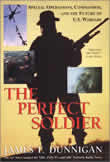
The Perfect Soldier: Special Operations, Commandos, and the Future of Us Warfare by James F. Dunnigan
More Books by James Dunnigan
|
The Phantom Menace
by James Dunnigan
December 26, 2009
The U.S. Army has bought 120,000 XSAPI bulletproof plates, for protective vests. These plates were specially designed to protect against a type of bullet that the army will not reveal. The XSAPI plates weigh about half a pound more than the current ESAPI plates, but are constructed of the same materials. Its believed the XSAPI provides protection against some kind of armor piercing bullets. These were long rumored to be used by Iraqi and Afghan terrorists. But, in fact, these bullets were never encountered. So, the theory goes, the XSAPI plates were never issued, and are held in reserve, just in case.
For two years now, the U.S. Army and Marines have been replacing existing SAPI (Small arms protective inserts) ceramic bulletproof plates (for protective vests), with thicker, but heavier ESAPI plates. The new ESAPI provides better protection from any kind of high powered bullet. The basic "Level 3" SAPI plates are 10x12 inches, weigh 4.6 pounds each and cost about $400. The older Level 4 plates, weighing about 6.4 pounds each, could stop some types of armor piercing bullets, and the new XSAPI weighs about six pounds and have somewhat greater stopping power. ESAPI is more expensive, at $600 a plate. Troops have noted that they rarely encountered enemy troops using armor piercing bullets. Thus the older SAPI plates were preferred, simply because they saved three pounds of weight. In fact, no one could actually produce any firm evidence of any kind of armor piercing bullets. That three pounds made a difference, probably more psychologically than physiologically. But weight is a big issue, especially when operating in tropical climates. Troops do all sorts of things to save weight, and using the less sturdy SAPI plates is just one of them. SAPI are made of boron carbide ceramic with a spectra shield backing. This combination causes bullets to fragment and slow down before getting through the plate. Occasionally, some fragments will get through, but these are stopped by the layers of Kevlar that make up the flak jackets. The ceramic plates require a manufacturing process that uses, and produces, a lot of toxic chemicals, much of the production has moved to China. The success of the plates, and the frequent attacks on U.S. troops in Iraq, has led the U.S. Army to try and get enough plates for all troops in the combat zone, not just those in infantry units. This is more of a morale issue than anything else, as non-infantry troops are most frequently exposed to bombs and RPGs. The fragments from these weapons can be stopped by the flack jackets without the plates. But morale is important, so the army is trying to get enough SAPI plates for everyone. The military plans to spend $6 billion on more XSAPI and ESAPI plates that many of the troops dont want. Actually, those troops who don't have to run around a lot, like those running convoys through hostile areas, don't mind the additional weight of ESAPI. But for the infantry, less weight is a lifesaver.
|
|
